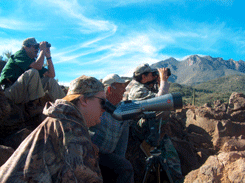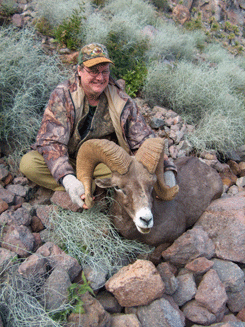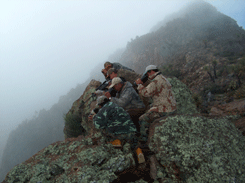Killing Endangered Species to Save Them
Air Date: Week of August 11, 2006

(Photo: Daniel Duane)
Killing animals to preserve a species? That’s the premise of a program designed to sell a limited number of permits to hunters in order to help communities conserve indigenous populations of endangered sheep. Author Daniel Duane went on his first hunt and wrote about it for Mother Jones magazine. He tells host Steve Curwood that after his experience, he had to re-think his notions about hunting.
Transcript
CURWOOD: Thirty years ago, it seemed that the magnificent bighorn sheep of the western mountains were headed for extinction. The bighorn is the most prized trophy of the four North American wild sheep species that hunters consider a grand slam. So, the Foundation for North American Wild Sheep came up with a program to save the endangered animals by killing just a few of them. Now, saving an endangered species by hunting them sounds like an oxymoron, but the organization had the notion that by getting a lot of money for a few hunting permits, they could raise money for sheep conservation and community development. The concept seemed unusual to writer Daniel Duane. So, he joined a foundation hunt in Vizcaino Biosphere, in the south of Baja, California, recently and wrote about that experience for Mother Jones magazine.
Dan Duane, welcome to Living on Earth.
DUANE: Thank you.
CURWOOD: Now as I understand it, before you started doing the research for this story, you had never been out hunting. So, what were your views on hunting up until then?
DUANE: Well, I didn’t have very well formed views. I grew up as an urban, liberal environmentalist, with most of my, well, all of my exposure to the outdoors being backpacking in California Sierra Nevada and that sort of thing, and the picture of the hunter, in my mind, wasn’t an especially favorable one. And I think if I had any view of them at all, it came from fairly cliched-notions picked up through TV and here and there. And, I don’t know, visions of beer-swilling guys driving around in pickups trying to blow away Bambi on the weekends and somehow feeling bigger about themselves when they managed to do it.
CURWOOD: So, that’s a pretty negative view, in other words.
DUANE: That’s a pretty negative view. Yeah.
CURWOOD: So, for this story, you end up going out on a trip with a man named Brian Drettmann. He’s a wealthy man who’s a seasoned hunter from Michigan and as I understand it, he’s paid $59,000 at an auction for a permit for, basically, for the right to hunt bighorn sheep which are considered endangered. But, how does this work?

Hunter Brian Drettmann paid $59,000 for the right to hunt this bighorn ram.
(Photo: Daniel Duane)
The killing of the endangered Bighorn sheep over the last 15 years through these FNAW permit programs has raised many, many millions of dollars for the conservation of those sheep and has been directly responsible for, I believe, it’s a four-fold increase in the number of wild sheep in North America.
CURWOOD: So, tell me about the hunt itself. What happened? You get up in the morning, and?
DUANE: Well, we get up before dawn. We load up our packs, you know, have breakfast around a fire, load up our packs and start up the mountain. The guides took us up sort of winding, snaking, very steep footpaths. At times we were scrambling on hands and feet. We gained a couple thousand feet elevation to get to a ridge near the summit of the mountain that would allow us to look down into the canyon where the sheep were, moving as quietly as possible and whispering and being careful not to drop anything or brush any sticks. We crept up to the edge there and looked over and down at the sheep. It took a while for Ramon the chief guide to figure out exactly which ram he wanted Brian to shoot.

High atop Mexico’s Tres Virgines volcano, hunter Brian Drettmann takes aim at a bighorn ram as guides uses binoculars and range finders to tell him which animal to shoot.(Photo: Daniel Duane)
CURWOOD: What was he looking for?
DUANE: He was looking for the oldest ram and the ram with the largest rack of horns.
CURWOOD: And, why is that good?
DUANE: That’s good for hunters because hunters like big racks of horns. And, it’s good for conservation because the oldest ram in the group has presumably had plenty of opportunity to spread his genetic diversity through the herd. So, Ramon eventually pointed to a particular ram down near a Yucca tree. There was a lot of anxious whispering back and forth between Brian and Ramon to make sure that Brian knew exactly which ram Roman had in mind. Once Brian was confident, he chambered a bullet in his rifle and settled his crosshairs on that ram and waited for the all clear. For a moment there was a ewe, a female Bighorn, standing directly behind the ram. So, there was some concern that the bullet could go through the ram and kill the ewe as well.
CURWOOD: What would happen if you killed the wrong ram or the ewe?
DUANE: It would have put a real smear on the hunt. It would have been very upsetting for everybody involved. The Ajiditarios are very committed to preserving their sheep. They place an enormous value on preserving their herd and a killed female is a small catastrophe for them. There also was a Mexican government game warden along, whose job was precisely to make sure that no mistakes of that kind were made. So it’s my sense that there would have been a great deal of paper work to do, and explanations to be made. It would have cast a real shadow over Drepman’s experience, for sure.
CURWOOD: So what happens next?
DUANE: What happens next is that finally that ewe moves, Ramon, the guide, hisses "listo," all clear, and, there’s a dead silence in the group for a beat and then this tremendous concussion as Brian pulls the trigger and the rifle bucks. The sheep had all sort of bolted; they had no idea what had happened, but of course they ‘d heard this terrifying noise. And, then came this groan sort of as Ramon was communicating that Brian had missed.
CURWOOD: We’re speaking with Daniel Duane about hunting endangered sheep in a bid to conserve them. We’ll join him back on the bighorn trail in just a minute.
[MUSIC: Tom Verlaine "Spiritual" from ‘Warm and Cool’ (Thrill Jockey – 2005)]
CURWOOD: Keep listening to Living on Earth.
[MUSIC: Roots Tonic "Instrument of the Trinity" from ‘Meets Bill Laswell’ (ROIR – 2006)]
CURWOOD: It’s Living on Earth. I’m Steve Curwood. We're back with Dan Duane who's telling us the story of his first hunt – a hunt that's sponsored by the Foundation for North American Wild Sheep, part of a program that allows hunting of the endangered sheep in order to conserve them. Our story continues as hunter Brian Drettmann, who had paid almost $60,000 for a permit to bag a bighorn sheep, has taken a shot and missed.
DUANE: Part of the problem had been that the range finder wasn’t working when Brian took that shot and he wasn’t sure how far away the sheep was. After that first shot missed, suddenly the range finder started working again and Brian got a clear view of his sheep. He got a clear read that it was 150 yards away. As he took the second shot, he did what I’m told a good hunter tries his best to do which is to let out a long, steady exhale as he squeezes the trigger. This time a cry went up among the guides that he had hit the target.
CURWOOD: And how did you feel?
DUANE: I was surprised to feel exhilarated by it. I had wondered what I would feel in that moment. I had really wondered in advance what I would feel watching a man shoot a Bighorn ram. Growing up in California and spending time in the mountains of California, the Bighorn had always loomed for me as the real sort of mystical inhabitants of the airy keeps of the high mountains. And, I wondered if I was going to feel revolted or saddened or something like that and I didn’t at all. I felt exhilarated by it. I felt excited by the adventure of it. I felt privileged to be along with these local men and watching them apply their woodcraft, their tracking and all of that. Another thought I had was, you know, please let me go this way. This guy was, he was near his expected life span anyway. He was in great health. He was eating from his favorite kind of bush. He was surrounded by all his descendants and family. And then the lights went out.
CURWOOD: So, how do you think your views on hunting changed after this hunt?
DUANE: Ray Lee, the CEO and president of the Foundation for North American Wild Sheep said to me that, in defending hunting, he said to me that, look this is the way people did it for tens of thousands of years. This is how people got food and now we all get our food wrapped in cellophane at the supermarket. And, if you ask a hunter what he’s doing out there, he’ll tell you: "Look, 362 days a year I get my food wrapped in cellophane and three days, on these three days a year when I go hunting, what I’m doing is putting myself back in, putting myself back into the natural world." And, as someone whose idea of being put back in the natural world has typically meant finding a gorgeous high mountain lake and watching the sunset, it was hard for me to accept the blood sport version of being put back in the natural world, until I was out on the mountain with that sheep, watching it being butchered and then eating it. I felt privileged to be there and I did feel that at least in the one setting in which I participated, hunting could really be an extraordinary way to participate in the rhythms of life.
CURWOOD: How do you feel about going hunting again, yourself?
DUANE: Well, I’m curious about it, you know. I was so enthusiastic about this that Brian has invited me to go turkey hunting with him in Michigan this spring and I’m really looking forward to it. I’m curious about it, you know, I mean, again I’m not sure what it’s going to feel like because I’ll be taking yet another step to actually pull the trigger. But, I plan to have a big dinner party afterwards and, you know, have roast wild turkey for a bunch of friends and learn some good recipes for stuffing, I guess.
CURWOOD: Daniel Duane is the author of the article, "Sacrificial Ram," in the March/April issue of Mother Jones magazine. Thanks so much for taking this time with me today.
DUANE: Thanks for having me.
Links
Living on Earth wants to hear from you!
Living on Earth
62 Calef Highway, Suite 212
Lee, NH 03861
Telephone: 617-287-4121
E-mail: comments@loe.org
Newsletter [Click here]
Donate to Living on Earth!
Living on Earth is an independent media program and relies entirely on contributions from listeners and institutions supporting public service. Please donate now to preserve an independent environmental voice.
NewsletterLiving on Earth offers a weekly delivery of the show's rundown to your mailbox. Sign up for our newsletter today!
 Sailors For The Sea: Be the change you want to sea.
Sailors For The Sea: Be the change you want to sea.
 The Grantham Foundation for the Protection of the Environment: Committed to protecting and improving the health of the global environment.
The Grantham Foundation for the Protection of the Environment: Committed to protecting and improving the health of the global environment.
 Contribute to Living on Earth and receive, as our gift to you, an archival print of one of Mark Seth Lender's extraordinary wildlife photographs. Follow the link to see Mark's current collection of photographs.
Contribute to Living on Earth and receive, as our gift to you, an archival print of one of Mark Seth Lender's extraordinary wildlife photographs. Follow the link to see Mark's current collection of photographs.
 Buy a signed copy of Mark Seth Lender's book Smeagull the Seagull & support Living on Earth
Buy a signed copy of Mark Seth Lender's book Smeagull the Seagull & support Living on Earth

